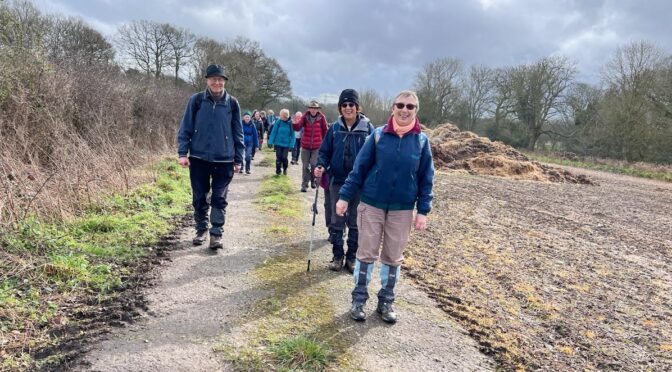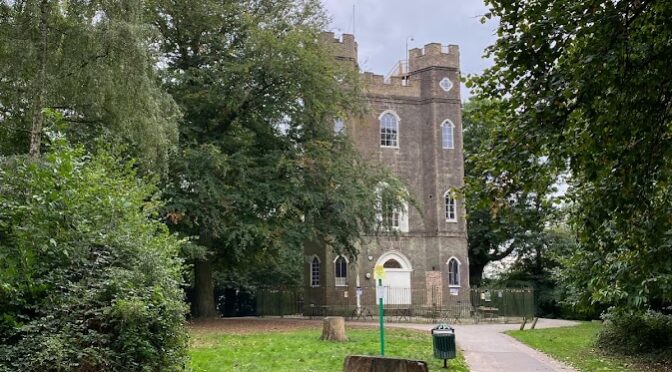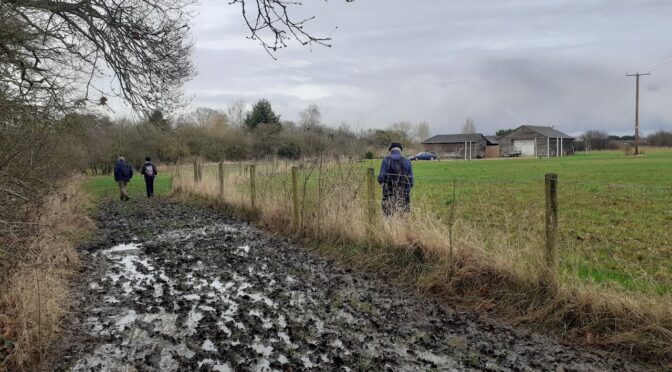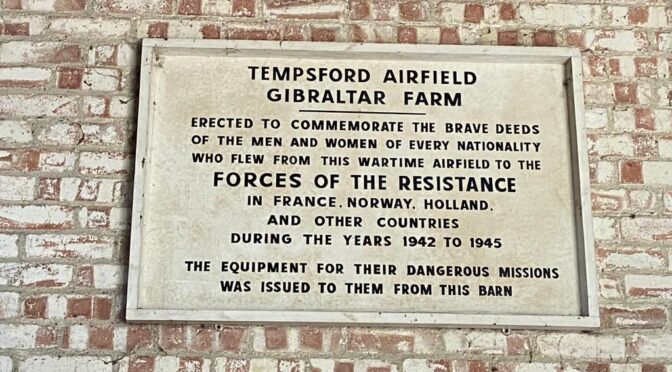Twenty five Poly Ramblers gathered at Uxbridge station on a mild and thankfully dry Saturday morning in early February. Unusually we split into two groups. I led a 6 mile walk south on the Grand Union Canal, then cutting across via the Slough Arm and Little Britain Lake and returning to the town on the London Loop alongside the River Colne. Meanwhile Danny led a similar but shorter loop for those who preferred a stroll or wanted to avoid mud. Continue reading Uxbridge and Battle of Britain Bunker – 3 February
Category Archives: Walk reports
THE SILCHESTER TRAIL FROM BRAMLEY – 24 FEBRUARY
I warned them it would be muddy but 22 Poly Ramblers joined me on this circular walk to the Roman town of Calleva Atrebatum, which has one of the best-preserved Roman town defences in England. Calleva Atrebatum was a flourishing Iron Age fortified town, the capital of the Atrebates tribe. It then became a walled town in the Roman province of Britannia, at a major crossroads of the roads of southern Britain. Unlike most major Roman settlements in southern England, Calleva Atrebatum was never re-occupied as a substantial settlement or built over, but instead became a small medieval village until it was deserted around the 5th century, possibly because of the black death plague that devastated medieval England. The museum of Reading in Reading Town Hall has a gallery devoted to Calleva, displaying many archaeological finds from the excavations. Continue reading THE SILCHESTER TRAIL FROM BRAMLEY – 24 FEBRUARY
MID-WEEK WALK: PART THREE OF THE GREEN LONDON WAY – 5 OCTOBER
After meeting at King George V DLR station, we walked to Woolwich Ferry North Terminal for our (free) cruise across the Thames. It was over too soon; we disembarked and continued along the river to Woolwich Arsenal which has been nicely renovated. We passed Woolwich Market and the former imposing home of the Woolwich Equitable Building Society before our first climb to reach Plumstead Common. After the wingless windmill situated above the Old Mill Public House, we continued on Winn’s Common which we crossed. We went down the valley and up the other side to Bostall Woods where we had our picnic in a clearing on tables and benches conveniently placed there. Continue reading MID-WEEK WALK: PART THREE OF THE GREEN LONDON WAY – 5 OCTOBER
FLITWICK RAMBLE – SATURDAY 10 FEBRUARY
I walked up to the station and when the train arrived before 11:00, 11 Poly Ramblers alighted, making up a party of 12. There had been a considerable amount of rainfall during the previous week. I thus advised the party of a Claggy field and a Squelchy track, during the final third of the ramble. Setting off beside Tesco’s car park and some residential roads, we continued along a straight tarmacked track, tree lined to the left and grassy on the right, leading off to several other residential areas until we reached an open area with a Motte and Bailey at one end. This led us to Dewpond Road and the Dew Pond itself featuring some aquatic birds. A left turn and right fork from here led us onto Church Road, being a narrow lane, where we passed the side of the Manor behind trees, and then the Parish Church. A little further down the lane we reached the main entrance gates to Flitwick Manor, where to one side of its driveway were carpeted in a bright white of snowdrops, Time here for some photoshoots! Continue reading FLITWICK RAMBLE – SATURDAY 10 FEBRUARY
SANDY TO TEMPSFORD – 1ST JULY 2023
Sixteen Polyagents reported for duty at Sandy station. After briefing we set off, up through woods and then along the Greensand Ridge Walk in the valley, northwards on a Roman road with a field of barley waving in the breeze on our left and hawthorn hedge on our right. First stop Gibraltar Barn, formerly part of Gibraltar Farm which was turned into a secret airfield for the RAF during WWII. As we were approaching on a rough but wide farm track, a few cars came towards us and some of the occupants waved at us as they went by. I didn’t inspect them closely which is a shame because the next day, when I returned to the memorial weekend event, I discovered from a French participant that the convoy of cars contained members of the Tempsford Veterans and Relatives Association and colleagues who had been at the Barn holding a memorial service and laying a plaque in French which we observed afterwards without realising how recent it was, honouring the people involved in the Resistance in occupied France. The Barn contains wreaths of poppies, photos and newspaper cuttings, letters and certificates referring to various pilots and Special Operations Executive (SOE) agents who flew from the airfield between 1942 and 1945 to work behind enemy lines. There were plaques in English and Polish (and other languages, including the plaque in French so recently laid there) honouring the men and women involved in the secret operations based at Tempsford and destined not only for France but as far afield as Norway, Denmark, the Netherlands and Poland. Some sources say that the Barn is where the agents were handed their kit before boarding the small planes, Lysanders and Halifaxes, which would take them to their mission on the continent. The historian Mark Seaman giving one of the talks on the Sunday stressed that the people who flew out of Tempsford were agents, whose mission was to send information back to base, liaise with the local resistance, to sabotage and disrupt life for the enemy, not ‘spies’ such as the SIS (Secret Intelligence Service aka MI6) operatives, working out of Godmanchester, who have gained more notoriety and were the object of Roger Leivers’ talk we listened to on the Saturday. As a lot of the relevant information is still classified and evidence needed to be destroyed as soon as possible to minimise the chances of it falling into enemy hands, it is often difficult for historians to research details of the agents’ activities. Continue reading SANDY TO TEMPSFORD – 1ST JULY 2023





